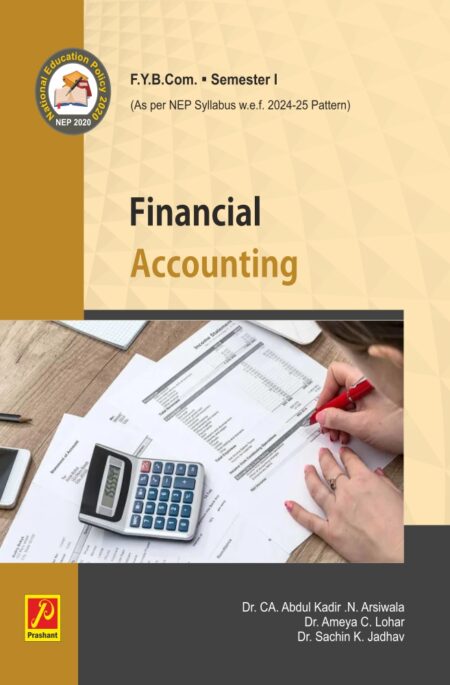-

Financial Accounting
₹150.00It is well said that ‘change is the only permanent thing in this world’. Therefore, any change in the curriculum of a subject is part of the natural process of development. Advancement in knowledge is possible only if a subject is taught and learned differently at different times. Since KBC North Maharashtra University is adopting a New Education Policy for First Year Students of Bachelor of Commerce, it is our duty to present the necessary learning material to them.
We are pleased to present the textbook on ‘Financial Accounting’ for F.Y.B.Com. students. It has been written in a teach-yourself style, following a student-friendly approach. Sufficient theory content and numerous examples covering all typical points are given. Illustrations in the book include questions from KBC NMU and other university examinations. Topics are arranged exactly according to the new syllabus.
The syllabus is divided into six units, each designed to provide a thorough understanding of key accounting principles and practices. Unit 1 covers the theoretical framework, including valuation principles, accounting estimates, and the scope of GAAP, Ind AS, and IFRS. Unit 2 focuses on the preparation of financial statements, such as the Trading and Profit & Loss Account, and the Balance Sheet, along with practical numerical problems. Unit 3 deals with the accounts of non-profit organizations, guiding students through the preparation of Receipts and Payment Accounts, Income and Expenditure Accounts, and Balance Sheets. Unit 4 explains the gradual realization and piecemeal distribution of cash on the dissolution of a partnership firm, including methods like the maximum loss method and the highest relative capital method. Unit 5 explores the conversion of a partnership firm into a limited company, detailing the meaning, need for conversion, calculation of purchase consideration, and closing entries. Finally, Unit 6 delves into joint venture accounting, distinguishing between joint ventures and partnerships, and outlining the accounting procedures for joint venture transactions when separate books are maintained. -

Investment and Wealth Management
₹175.00Investment may be defined as an activity that commits funds in any financial / physical form in the present with an expectation of receiving additional return in the future. The expectation brings with it a probability that the quantum of return may vary from a minimum to a maximum. This possibility of variation in the actual return is known as investment risk. Thus every investment involves a return and risk. A portfolio is a combination of various assets and / or instruments of investments.
Wealth management is a high-level professional service that combines financial / investment advice, accounting / tax services, retirement planning and legal / estate planning for one fee. Therefore, it is more than just investment advice, as it can encompass all parts of investor‘s financial life. It’s never to early or too late, to start about investment and wealth management. -

गुंतवणूक आणि संपत्ती व्यवस्थापन
₹175.00‘गुंतवणूक आणि संपत्ती व्यवस्थापन’ या पुस्तकात गुंतवणूक, प्रकार, वैशिष्ट्ये, उद्दिष्ट्ये, गुंतवणुकदरांचे प्रकार, पोर्टफोलिओ व्यवस्थापन, जोखीम आणि परतावा, वित्तीय संपत्तीवरील परतावा, जोखीमेचे मोजमाप, पद्धतशीर जोखमीचे स्रोत, गुंतवणूकीचे पर्याय, गुंतवणूकीचे मूल्यमापन, किंमत-उत्पन्न संबंध, व्याज दराची संरचना, संपत्ती व्यवस्थापन, व्याप्ती, घटक, प्रक्रिया, गरज, पक्षकाराच्या अपेक्षा, वैयक्तिक आर्थिक विवरण, वित्तीय साक्षरता, रोख प्रवाह, वित्तीय नियोजन बांधणी, वैयक्तिक आर्थिक नियोजन, गरज, फायदे, तत्वे इत्यादी मूलभूत संकल्पना स्पष्ट करण्यात आलेले आहेत. योग्य त्या ठिकाणी आकृत्या काढून स्पष्टीकरण देण्यात आलेले आहे. पुस्तकाची अत्यंत साध्या व सोप्या भाषेत मांडणी केलेली आहे.
प्रस्तुत पुस्तक वाणिज्य आणि व्यवस्थापन विज्ञान शाखेच्या विद्यार्थ्यांना, प्राध्यापकांना निश्चितच उपयुक्त ठरेल.Guntavnuk Ani Sampatti Vyavsthapan
